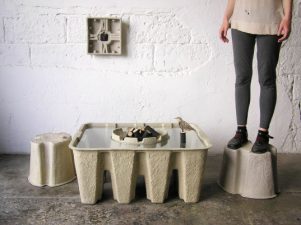 Sustainable design is about more than energy efficiency and recyclable parts, says Gadi Amit. Beauty is no less important.
Sustainable design is about more than energy efficiency and recyclable parts, says Gadi Amit. Beauty is no less important.
When we think about sustainable design, there are some key concepts that come to mind: cradle-to-cradle (or the idea that all materials put into a product can be recycled for use in another), the use of sustainable, recycled, or upcycled materials, and energy efficiency. But among all these new green ideas and buzz words floating around, one of the most fundamental design concepts has been pushed aside: beauty. And that, according to Israeli-born industrial designer Gadi Amit (the person responsible for the design of the Better Place charge spots), is a really big mistake.
 In a recent interview with Fast Company Magazine, Amit shared his true feelings on the direction that the sustainable design movement is currently headed and suggested a return to tried-and-true values. In Amit’s own words,
In a recent interview with Fast Company Magazine, Amit shared his true feelings on the direction that the sustainable design movement is currently headed and suggested a return to tried-and-true values. In Amit’s own words,
“The problem with sustainability design today is the perception that it’s pure mechanics — let’s analyze carbon impact, toxicity, and so on. What I’m saying always is, Guys, you’re wrong. Objects have a cultural meaning, and objects that are lovable, that are well integrated into culture, won’t be trashed after five years, and so are sustainable. If the object is connecting emotionally, connecting culturally, people will keep it. We still have people using Palm Zire, which we designed eight years ago, even though it’s a completely obsolete technology. The bottom line is there’s no replacement for emotional connection. Sustainability promoters need to understand that without this emotional, cultural enabler, they face a very tough uphill battle.”
Emotional connection, aesthetic appreciation, and generally wanting to keep an object around, then, may be no less important in designing a sustainable object than energy efficiency, carbon footprint, etc. Beauty, and even sex appeal, contribute to sustainability.
Amit went on to say that “The nuances of form, imbuing sex appeal into an object, is what we do here. The products have got to sell. We all need to reduce our toxicity and effect on the environment, but we need to be able to do it happily and without too much guilt — in a positive way rather than in a negative way.”
Image via: Fast Company Magazine
Read more about Gadi Amit and sustainable design::
NewDealDesign’s Gadi Amit Designs Charge Spots for Better Place Electric Cars
Eco Design Basics on Cradle to Grave vs. Cradle to Cradle
Blogger Yuli Ziv on Green Trands and Sustainable Designs



